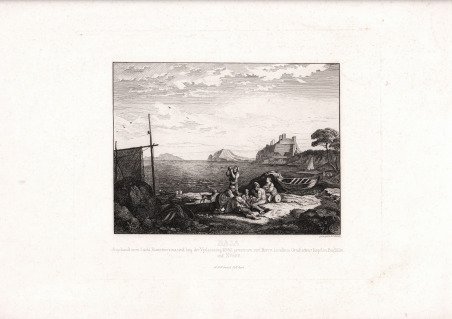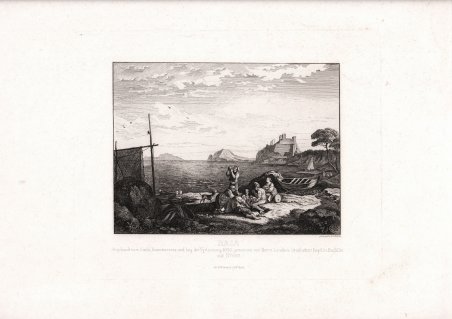Détails
Graveurs
RICHTER Adrian Ludwig
Description
Tavola 2 dell’opera Die Bilder-Chronik des Sächsischen Kunstvereins Dresden 1828 – 1836. Da un dipinto di Ludwig Richter. Aquaforte, in ottimo stato di conservazione. All'inizio del XIX secolo, un nuovo spirito si agitava nella società borghese in Germania: Nelle città si formarono dei circoli letterari, sostenuti e frequentati da uomini e donne di mentalità riformista. Questa situazione preparò il terreno per la fondazione delle prime associazioni d'arte negli stati tedeschi. Durante la celebrazione di Dürer a Dresda il 7 aprile 1828, Carl August Böttiger chiese la fondazione di un'associazione artistica. Giovani artisti sassoni come Carl Peschel, Ludwig Richter, Christian Friedrich Gille, Ernst Ferdinand Oehme e molti altri beneficiarono di questo sostegno. Ma anche i rappresentanti del primo romanticismo di Dresda come Caspar David Friedrich, Georg Friedrich Kersting e Louise Seidler poterono vendere i loro quadri attraverso il Kunstverein. La pubblicazione del Bilder-Chronik, in cui le opere acquistate venivano presentate ai membri del Kunstverein come incisioni su rame, serviva non solo alla diffusione dell'arte contemporanea, ma anche alla promozione globale dell'arte dell'incisione su rame. Fondamentalmente, la Sächsische Bilder-Chronik (Cronaca pittorica sassone) dal 1828 al 1836 offre l'opportunità di ottenere una visione completa dello sviluppo dell'arte nella prima metà del XIX secolo, che ha portato dal Classicismo al Romanticismo e all'inizio del Biedermeier. Plate 2 from Die Bilder-Chronik des Sächsischen Kunstvereins Dresden 1828 – 1836. After a painting by Ludwid Richter. Etching, in very good condition. At the beginning of the 19th century, a new spirit was stirring in bourgeois society in Germany: Literary circles formed in the cities, supported and attended by reform-minded men and women. This situation prepared the ground for the founding of the first art associations in the German states. During the Dürer celebration in Dresden on April 7, 1828, Carl August Böttiger called for the founding of an art association. Young Saxon artists such as Carl Peschel, Ludwig Richter, Christian Friedrich Gille, Ernst Ferdinand Oehme and many others benefited from this support. But also the representatives of Dresden's early Romanticism such as Caspar David Friedrich, Georg Friedrich Kersting and Louise Seidler were able to sell their paintings through the Kunstverein. The publication of the Bilder-Chronik, in which the purchased works were presented to the members of the Kunstverein as copper engravings, served not only to disseminate contemporary fine art but also to comprehensively promote the art of copper engraving. Basically, the Sächsische Bilder-Chronik from 1828 to 1836 offers the opportunity to gain a comprehensive insight into the development of art in the first half of the 19th century, which led from Classicism to Romanticism and the beginning of Biedermeier Realism. Cfr.


Découvrez comment utiliser
Découvrez comment utiliser

